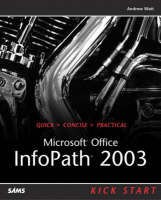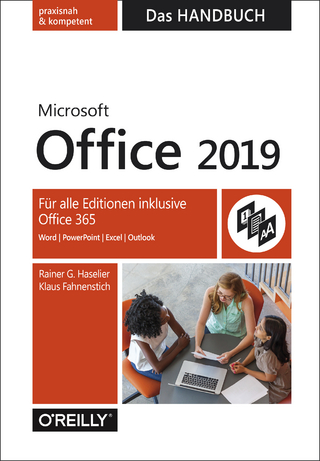
Microsoft Office InfoPath 2003 Kick Start
Sams Publishing (Verlag)
978-0-672-32623-3 (ISBN)
- Titel ist leider vergriffen;
keine Neuauflage - Artikel merken
Microsoft InfoPath 2003 Kick Start builds upon the reader's knowledge of the Microsoft Office system to enable them to get right to work making productive use of InfoPath. It is targeted specifically at the early adopters - developers who will use their knowledge of XML and Web development to build sophisticated applications with InfoPath front ends. However it is also, carefully structured to enable "front line" InfoPath users to quickly glean the information they need to be productive when developing their own InfoPath forms - and when working with developers to create more involved InfoPath applications.
Andrew Watt, a Microsoft MVP for InfoPath 2003, is an independent consultant and experienced author with an interest and expertise in XML technologies, including XPath, XSLT, W3C XML Schema, and SVG. He is the author of Designing SVG Web Graphics (New Riders), XPath Essentials (Wiley), Sams Teach Yourself XML in 10 Minutes (Sams), and the forthcoming XSLT 2.0 Kick Start (Sams). He is coauthor of XML Schema Essentials (Wiley), Sams Teach Yourself JavaScript in 21 Days, and SVG Unleashed (both published by Sams). He is a contributing author to XHTML, XML & Java 2 Platinum Edition and XHTML By Example (Que); Professional XSL; Professional XML, 2nd Edition; Professional XML Meta Data; Beginning J2EE 1.4 (Wrox); and Special Edition Using XML, 2nd Edition (Que).
Introduction.
I. USING THE INFOPATH VISUAL INTERFACE.
1. Getting Started with InfoPath.
Defining InfoPath. Installing InfoPath. Connecting to an Access Database. Creating a Simple Scripted InfoPath Form. In Brief.
2. InfoPath Is Different.
Understanding How InfoPath Is Different. What InfoPath Is Not. Programming Languages. Database and XML Web Service Front-End Tool. Automatic Data Validation. Dynamic Forms. Filling In Forms Offline. Conditional Formatting. InfoPath Security. Publishing InfoPath Form Templates. Digitally Signing InfoPath Forms. In Brief.
3. The InfoPath Workspace and Workflow.
Form-Filling Mode—The User's View. Filling In Forms. Design Mode—Your Toolset. The Form Area. The Task Pane. Form Views. Setting InfoPath Options. In Brief.
4. InfoPath Form Controls.
What Is a Form Control? The Text Box Control. The Rich Text Box Control. The Drop-Down List Box Control. The List Box Control. The Date Picker Control. The Check Box Control. The Option Button Control. The Section Control. The Optional Section Control. The Repeating Section Control. The Repeating Table Control. List Form Controls. The Button Control. The Hyperlink Control. The Picture Control. The Expression Box Control. The Ink Picture Control. In Brief.
5. Expression Boxes.
What an Expression Box Is. Using XPath in Expression Boxes. In Brief.
6. Designing Visual Aspects of InfoPath Forms.
Creating a View Layout. Copying a View Layout. Applying a Color Scheme. Styling Form Controls. Conditional Formatting. In Brief.
7. Connecting to a Database.
Connecting to Microsoft Access. Connecting to Microsoft SQL Server. In Brief.
8. Connecting to a Web Service.
Preparations for Deploying an XML Web Service. Configuring and Testing the InfoPath SDK Samples. Limitations of InfoPath XML Web Service Support. Designing a Template to Connect to a Web Service. In Brief.
9. Saving, Publishing, and Submitting InfoPath Forms.
Saving Form Templates and Forms. Publishing an InfoPath Form Template. Sharing InfoPath Forms. Submitting an InfoPath Form. In Brief.
10. Validating Form Data.
InfoPath's Three Validation Tools. Using W3C XML Schema. Script-Based Validation. Rules-Based Validation. In Brief.
11. Updating and Modifying InfoPath Forms.
Versions of InfoPath Form Templates. Modifying the Data Source. An Alternative Approach. In Brief.
12. Security and InfoPath Forms.
Overview of Security in InfoPath. InfoPath Security and Internet Explorer. Sandboxed InfoPath Form Templates. Object Model Security Levels. Fully Trusted InfoPath Forms. Digitally Signing an InfoPath Form. Signing a Form. The Need for a Security Policy. In Brief.
13. Using InfoPath with Windows SharePoint Services.
Windows SharePoint Services Overview. Creating a Form Template and Form Library. In Brief.
14. Planning InfoPath Solutions.
Considering Whether InfoPath Is the Appropriate Solution. Defining the Problem. Defining the Necessary Data. Planning Training and User Documentation. In Brief.
II. UNDER THE HOOD.
15. Understanding the .xsn File.
The Content and Purpose of the .xsn File. The .xml Template File. The .xsf Manifest File. The .xsl View Files. The .xsd Schema Files. The Script Files. Executable Files. Miscellaneous Files. In Brief.
16. The Manifest File.
Overview of the Manifest File. The Element. The Element. View-Controlling Elements. The Element. The Element. Toolbar and Menu-Related Elements. The Element. In Brief.
17. Scripting in InfoPath.
The Scripting Environment. JScript. VBScript. MSXML 5.0. The XML DOM in InfoPath. In Brief.
18. The InfoPath Object Model.
Introducing the InfoPath Object Model. The Application Object. The ADOAdapter Object. The DataDOM Object. The DataDOMEvent Object. The DataObject Object. The DocActionEvent Object. The DocEvent Object. The DocReturn Object. The Error Object. The ExternalApplication Object. The HTMLTaskPane Object. The HTMLTaskPaneExternal Object. The MailEnvelope Object. The Solution Object. The TaskPane Object. The UI Object. The VersionUpgradeEvent Object. The View Object. The ViewInfo Object. The WebServiceAdapter Object. The Window Object. The XDocument Object. The XMLFileAdapter Object. InfoPath Collections. In Brief.
19. Events in InfoPath.
Overview of InfoPath Events. Form Events. Validation Events. In Brief.
Glossary.
Index.
| Erscheint lt. Verlag | 7.4.2004 |
|---|---|
| Verlagsort | Indianapolis |
| Sprache | englisch |
| Maße | 187 x 231 mm |
| Gewicht | 676 g |
| Themenwelt | Informatik ► Office Programme ► Office |
| ISBN-10 | 0-672-32623-X / 067232623X |
| ISBN-13 | 978-0-672-32623-3 / 9780672326233 |
| Zustand | Neuware |
| Informationen gemäß Produktsicherheitsverordnung (GPSR) | |
| Haben Sie eine Frage zum Produkt? |
aus dem Bereich


